

In order to set some definite transformation value, it is the rotation angle in our case, keep Option / Alt keys down at the moment of establishing of center rotation. If you keep the Option / Alt keys down while rotating then your original object will be duplicated. After selecting this tool you need to select the object and set a point against which the rotation will be made. Let’s check out the functionality of these tools on the example of Rotate Tool (R). These are Rotate Tool (R), Reflect Tool (O), Scale Tool (S), Shear Tool (C) and Reshape Tool. There are two blocks of tools for the object transformation. Transformation and Doubling of Objects with the Help of Tools This method is also good in fast creation of vector textures. Now reduce the Scale value and set any value for the move value and rotation angle, and then tick Random and Preview.Īs you can see, we quickly made some diversity in our composition. Select the objects, then go to Object > Transform > Transform Each…. Let’s check how we can apply it to a couple of objects. The other command, Transform Each, from the menu Object > Transform >… allows us to make a couple of transformations with an object or some objects at the same time. will double and move the selected object in this case. Now the usage of Command / Ctrl + D shortcuts will repeat the last action, i.e. Select the object, then go to the Object > Transform > Move… and set the move value in the dialog box then click on Copy button. Suppose we need to place the same objects on a given distance from each other. Let us see the practicality of this command. There is also a useful command Transform again (Command/ Ctrl + D) in the menu Object > Transform >…. Try Startup App Try Slides App Other Products With Startup App and Slides App you can build unlimited websites using the online website editor which includes ready-made designed and coded elements, templates and themes. Any of these commands opens the dialog box in which you enter the required parameters, for example the rotation angle.Īll dialog boxes of these commands have Copy button, when the copy button is clicked the object will be transformed and doubled. These are Move, Rotate, Reflect, Scale and Shear. There are 5 commands in the “Object” Menu (Object > Transform > …) which can transform objects to specified value. Transformation and Doubling of Objects Using Menu Commands In order to move and double an object, keep Option/ Alt keys selected while moving. It is often necessary to place a copy of an object in some new place. When you select the sublayer in Layers panel (Window > Layer) you will have an opportunity to double the object by selecting Duplicate “” in the fly-out menu.īy the way, I always work with open Layers panel, this allows following the changes and controlling the objects in the work process.
Illustrator export vector code how to#
Thanks for watching, and stay tuned to Creative Nerds for quick tips on how to use Photoshop and Illustrator.With Postcards you can create and edit email templates online without any coding skills! Includes more than 100 components to help you create custom emails templates faster than ever before. Thanks for watching, and I hope it’s one that you can incorporate into your Web design projects. It’s then…that’s basically the Vector shape as an SVG that’s imported onto the page. So we’re gonna create a new Pen, and I’m simply gonna paste in that HTML.

So, I’m gonna use CodePen for this example. So, we’re just gonna simply select CTRL+A so we can copy the whole of it, and then we’re gonna open into a HTML editor. And it will then open this dialog box in a Notepad file, and this basically is the path and the coordinates for our Vector shape. And it will bring up this dialog menu called SVG Options, and the option that we’re looking for is SVG Code. And we’re not gonna give it a name because that’s not important, and we’re just going to select Save. So, what you wanna do, firstly, is start off by heading over to File and selecting Save As, and it wants us to choose the type to be SVG.

So, this works for any piece of artwork that’s been created from Illustrator that’s a scaleable vector.
Illustrator export vector code code#
Today, we have a screencast to show you how you can export an SVG image within Illustrator and grab the SVG code so it can then be incorporated straight into a Web design project.


 0 kommentar(er)
0 kommentar(er)
